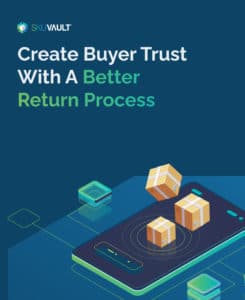Turn Peak Season Returns Into Revenue

Like many eCommerce merchants your team is probably gearing up for the boom in peak season sales, and subsequently, peak season returns.
Counting inventory, making sure all items are listed, and scheduling shipments for the last minute purchase orders to arrive are top priority.
What you may not be ready for are the flood of returns in January. In this blog post we will discuss a few tips and tricks on how to streamline your returns processes and strategies to change reviews from a costly hassle to a new stream of revenue.
Prepare for Peak Season Returns Volume
How many returns did you receive last year during peak season?
Retailers can estimate returns volume by multiplying your sales growth by the number of returns you had during last peak season.
Not everyone has fancy systems to report how many returns you’ve received last year, so let’s take a guess. Did you know that 20%-50% of eCommerce orders are returned?
Let’s do the math. That’s around 8,000 returns if you process 5,000 orders per day Black Friday through Cyber Monday. Now that you have an idea of how many returns you will process during peak season, it’s time to put a game plan together.
Returns Policy
The first step to streamline your returns process is to make sure your company has an easy and comprehensive returns policy.
If you already have a returns policy in place, now is a good time to make sure your website and packing slip templates are up-to-date.
Marketplaces like Amazon have their own return policies. But if you have your own website you will need your own returns policy.
When you have a clear returns policy in place you will reduce confusion and time spent clearing up questions with customers. There are a ton of great resources to help you craft the perfect policy.
Need an Improved Return Process?
Implementing a better return process is just as important as providing a valuable product to create trust with your buyer. Download this eBook to learn how.
Returns Shipping
If 25% or more of your orders are returned, shipping can quickly add up.
Consumer expectations have changed since Amazon updated their returns policy to provide free returns shipping. Offering free returns to your customers can be an effective strategy to win competition from your competitors.
However, your business could quickly lose money if your price, shipping rates, and returns processes are not optimized to handle a high volume of returns.
The best way to ensure that free returns have a positive impact on your growth is to plan accordingly. Have a handle on current returns rates and accounting for an increase with free returns.
Exchanges and Replacements
In many industries, exchanges and replacements happen quite often.
Some common examples include apparel merchants issuing exchanges due to sizing or automotive parts seller replacing faulty parts. Merchants that commonly issue exchange or replacement orders can be overwhelmed by manual and paper-driven processes.
If your customer service agents spend hours digging through printed packing slips to match with one of the packages in a cart full of returns, it’s probably time to change to a system that can accommodate automated RMA functionality.
RMA stands for Return Merchandise Authorization, which is basically another way to say an invoice that you receive a return against.
Upsell For Success
So, how do you turn returns into revenue? It’s simple: upsells!
If your customer is submitting a return, chances are you have already had a chance to communicate with them through phone or email. Use this time to your advantage.
The best way to achieve victory with upsells is to arm your Customer Service Reps (CSR) with the knowledge they need to upsell effectively. Have your merchandising team train them on similar items and upgrades.
How to Measure Success
You may be thinking, “Wow that is a great idea, but how do I know if it’s working?” It’s simple. Track your customer service agents as sales reps.
If you’re not using an automated Customer Relationship Management System (CRM) that tracks sales activity, set up a Google Doc. Each employee will enter the original order value, the returned line item(s), the price of each line item, the exchange items, and exchange item price. That way you can see how well your CSRs are performing.
Everyone likes to feel appreciated, so once you have a solid process and way to track performance in place, it’s time to structure bonuses. If you incentivize your CSRs to upsell exchanges, you’re re-enforcing the positive behavior to increase wallet share.
Conclusion
Once you have implemented these steps effectively, just sit back and wait for returns and a chance to upsell your customers. If you would like to learn more about how to be more successful in your returns process visit CloudConversion.com
